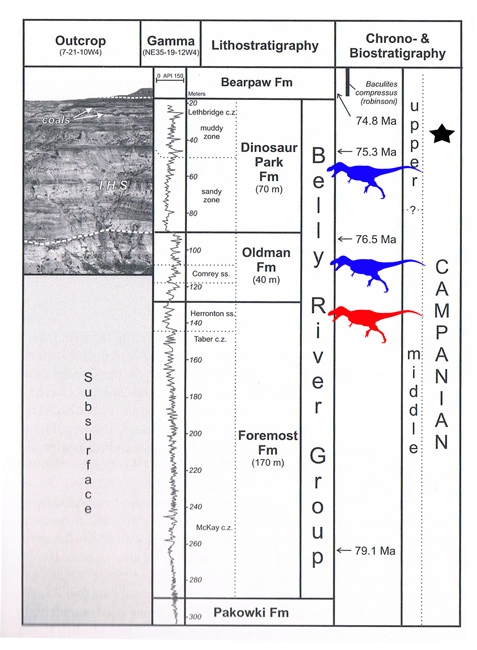Canada’s Newest and Oldest Tyrannosaurid – Thanatotheristes degrootorum
Researchers from the University of Calgary and the Royal Tyrrell Museum (Alberta, Canada), have published a scientific paper describing a new species of tyrannosaur, based on fragmentary skull and jaw elements excavated from Campanian-aged deposits representing the Foremost Formation of Alberta. The Foremost Formation is the oldest geological formation ascribed to the Belly River Group, it is overlain by the Oldman Formation and the Dinosaur Park Formation. The newly named tyrannosaurid is Thanatotheristes degrootorum and its fossilised remains represent the earliest known evidence of diagnostic tyrannosaurid material to have been discovered in Canada.
A Silhouette of the Skull of Thanatotheristes degrootorum
Picture credit: Science Direct/The Journal of Cretaceous Research
The Evolution of North American Tyrannosaurs
Whilst tyrannosaurid fossil material is synonymous with Upper Campanian and Maastrichtian-aged deposits in North America, very little tyrannosaur fossil material has been recovered from older Campanian deposits. In the autumn of 2018, Everything Dinosaur published an article on a new species of tyrannosaurid (Dynamoterror dynastes), which had been found in Lower to Mid Campanian-aged deposits in New Mexico.
Prior to the discovery of Dynamoterror, the fossil record for these types of theropods had been largely restricted to a period from approximately 77 million years ago to the K-Pg extinction event. Dynamoterror roamed southern Laramidia around 80 million years ago, the fossils associated with T. degrootorum are roughly contemporaneous (dated from 80.1 to 79.5 million years ago). Together, the northern Thanatotheristes and the southern Dynamoterror will help scientists to better understand tyrannosaurid evolution in North America.
To read our article about Dynamoterror dynastes: Powerful Terror Ruler Dynamoterror dynastes.
A Sister Taxon to Daspletosaurus spp.
The researchers, which included Darla Zelenitsky (University of Calgary) and Caleb Brown (Royal Tyrrell Museum of Palaeontology), define Thanatotheristes as the sister taxon to the later tyrannosaurid genus Daspletosaurus. Together, these taxa provide evidence for the existence of a clade of long and deep-snouted tyrannosaurines endemic to northern Laramidia during the Campanian.
The clade has been named the Daspletosaurini and comprises Thanatotheristes (pronounced Than-ah-toe-ther-ris-tees) and the two known species of Daspletosaurus. D. torosus is associated with the Oldman and Dinosaur Park Formations of Alberta, whilst the recently described (2017), Daspletosaurus horneri is from the uppermost parts of the geologically slightly younger, Two Medicine Formation of Montana. Other proposed Daspletosaurus material is awaiting scientific description, so it is probable that additional species may be added to the Daspletosaurus genus.
The scientists conclude that the Tyrannosauridae family in North America consisted of several geographically segregated clades rather than a series of monogeneric (a genus with just one species in it), successive sister taxa as postulated in previous studies.
The Stratigraphy of the Belly River Group Showing Approximate Locations in Geological Time of Described Daspletosaurini

Picture credit: Everything Dinosaur from D. Eberth (Dinosaur Provincial Park)
The Stratigraphy of the Belly River Group
The figure (above) shows the stratigraphy of the Belly River Group and its component formations. The theropod shape (red) shows the approximate chronological location of the Thanatotheristes degrootorum fossil material, whilst the blue theropod silhouettes represent the approximate chronological location of Daspletosaurus fossil material. The black star shape represents the approximate age of Daspletosaurus horneri fossil material from the Two Medicine Formation.
It can be speculated that geographically dispersed but temporally contemporaneous genera such as Daspletosaurus and Thanatotheristes adds support to the theory that distinct regional faunas evolved on Laramidia during the Late Cretaceous. There may have been physical barriers that prevented the mixing of faunas on this landmass, this led to provincial ecosystems, with different parts of Laramidia having different types of dinosaur associated with them.
The Beasts of the Mesozoic range of articulated figures has recently introduced a tyrannosaur series.
To view this range: Beasts of the Mesozoic.
Thanatotheristes degrootorum
The skull of Thanatotheristes degrootorum is estimated to have measured around 80 cm in length, but the actual size of this dinosaur is uncertain as the fossils probably represent a sub-adult.
The scientific paper: “A new tyrannosaurine (Theropoda:Tyrannosauridae) from the Campanian Foremost Formation of Alberta, Canada, provides insight into the evolution and biogeography of tyrannosaurids” by Jared T. Voris, François Therrien, Darla K. Zelenitsky, and Caleb M. Brown published in the Journal of Cretaceous Research.
Visit the Everything Dinosaur website: Everything Dinosaur.







Thank you for this post it’s been very helpful!!